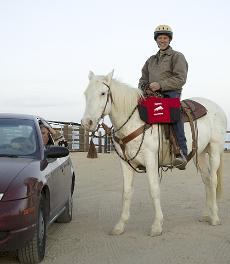Antonio Hernandez
The sun has yet to come up and still slumbers behind the rolling hills that line the San Fernando Valley. The street outside is quiet and awaiting the avalanche of cars that will descend upon it like clockwork.
Most students in the Valley are sleeping, but not Ismael Siciliano.
Siciliano, an 18-year-old freshman at Pierce College, is already awake and dressed. Backpack slung around his shoulder, he is walking the empty streets and making his way to the bus stop. Siciliano wakes up at 4 a.m. Monday through Thursday to take the 233 Bus Route from Panorama City to the Van Nuys Orange Line station.
The Metro Orange Line opened in October 2005, and according to the Los Angeles County Metropolitan Transportation Authority (MTA), annual Orange Line ridership from July 2006 through June 2007 totaled 6,737,278 boarding passengers.
Last month’s weekday ridership alone averaged 23,828 boarding passengers.
Getting off the bus at Van Nuys Boulevard, Siciliano then transfers to the Metro Orange Line. The bus runs through the heart of the Valley and stops almost directly in front of Pierce, on the northeast corner of Victory Boulevard and Winnetka Avenue.
Why in the world would he wake up at 4.a.m?
“The whole trip takes about an hour, that’s why I wake up at 4,” said Siciliano.
His first class, Math 125, begins at 6:40 a.m. and according to Siciliano, he has never been late.
“My friends think I’m insane for having this schedule. I’m definitely not doing the same thing next semester.” he said.
The Orange Line is an option for the many Pierce students that do not drive, or simply do not want to make the drive to school. The 101 Freeway, which many Pierce students take to get to campus, is notorious for its traffic.
“I usually have to take side streets in order to make it to class on time,” said Margarita Valenzuela, a full-time student at Pierce.
Valenzuela leaves Burbank at 7 a.m. in order to get to her first class at 8 a.m. Though the trip is tedious and sometimes frustrating, she believes the benefits of driving outweigh its inconvenience.
“It’s better to drive. You aren’t tethered down to the campus and forced to hang around until your bus comes or forced to eat here. Actually, if there were better places to eat on campus, I would have taken the Orange Line,” she said.
Even with gas prices currently more than $3 a gallon, a majority of Pierce students continue to drive instead of taking public transportation.
“It’s about freedom and choice,” said Nick Cohen, a full-time student who also drives to Pierce.
Cohen usually opts to park on Oxnard Street instead of trying to brave Pierce’s seven student parking lots.
“I have a lot of friends who come to Pierce and always find parking spots. Somehow, every time I look at the filled-up lots, I don’t believe them,” he said.
“I usually have trouble finding parking in Lot 7,” said Andriana Olieaves, 18, a first-year student at Pierce.
“I drive because it is convenient, but I think Pierce needs more parking structures. Many people, including myself, can’t find parking and end up being late to class,” she said.
When it comes down to driving or taking public transportation, it may not come down to the gas prices, traffic and parking. It may actually just come down to freedom and choice.
“If I had a choice to drive or take the bus, I would definitely drive if I had a car,” said Siciliano.

Students have many different modes of transportation to choose from to get around town. (Sevasti Iyama)
